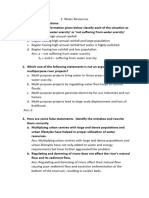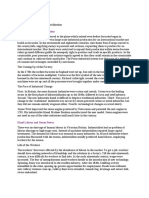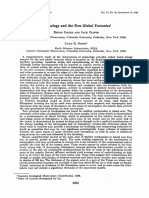Water Resoueces
Uploaded by
Maria JohncyWater Resoueces
Uploaded by
Maria JohncyWater Resoueces
Three-fourth of the earth’s surface is covered with water but only a small proportion of it accounts for freshwater, that can be put to use. Water is a
renewable resource.
Water Scarcity and the Need for Water Conservation and Management
The availability of water resources varies over space and time.
*Water scarcity is caused by over-exploitation, excessive use and unequal access to water among different social groups.
*Water resources are being over-exploited to expand irrigated areas for dry-season agriculture.
*In some areas, water is sufficiently available to meet the needs of the people. But, those areas still suffer from water scarcity due to bad
quality of water.
The need of the hour is to conserve and manage our water resources:
*To safeguard ourselves from health hazards.
*To ensure food security, continuation of our livelihoods and productive activities.
*To prevent degradation of our natural ecosystems.
Multi-Purpose River Projects and Integrated Water Resources Management
In ancient times, we used to conserve water by constructing sophisticated hydraulic structures like dams built of stone rubble, reservoirs or lakes,
embankments and canals for irrigation. We have continued this tradition in modern India by building dams in most of our river basins.
Dams
A dam is a barrier across flowing water that obstructs, directs or retards the flow, often creating a reservoir, lake or impoundment. “Dam” refers to the
reservoir rather than the structure.
Uses of Dam: Dams are built:
-To impound rivers and rainwater that can be used later to irrigate agricultural fields.
-For electricity generation.
-Water supply for domestic and industrial uses.
-Flood control.
-Recreation, inland navigation and fish breeding.
Side effects of Creating Dams
-Regulating and damming of rivers affect their natural flow.
-Poorer the habitats for the rivers’ aquatic life.
-Fragment rivers make it difficult for aquatic fauna to migrate.
-Dams created on the floodplains submerge the existing vegetation and soil leading to its decomposition over a period of time.
-Creating of large dams has been the cause of many new environmental movements like the ‘Narmada Bachao Andolan’ and the ‘Tehri Dam
Andolan’ etc.Many times local people had to give up their land, livelihood and their control over resources for the construction of the dam.
Most of the objections to the projects arose due to their failure to achieve the purposes for which they were built. Most of the dams were
constructed to control floods but, these dams have triggered floods. Dams have also caused extensive soil erosion. Excessive use of water
has resulted in earthquakes, caused water-borne diseases and pests and pollution.
Have a look at the India Major Rivers and Dams in the map below:
Rain Water Harvesting
Rainwater harvesting is a simple method by which rainfall is collected for future usage. The collected rainwater may be stored, utilised in different ways or
directly used for recharge purposes.
Different methods have been adopted in different areas for Rain Water Harvesting.
In hill and mountainous regions, people have built diversion channels like the ‘guls’ or ‘kuls’ of the Western Himalayas for agriculture.
“Rooftop rainwater harvesting” is commonly practised to store drinking water, particularly in Rajasthan.
In the flood plains of Bengal, people developed inundation channels to irrigate their fields.
In arid and semi-arid regions, agricultural fields were converted into rain-fed storage structures that allowed the water to stand and moisten the soil such as
‘khadins’ in Jaisalmer and ‘Johads’ in other parts of Rajasthan.
The tankas are part of the well-developed rooftop rainwater harvesting system and are built inside the main house or the courtyard. This is mainly practised
in Rajasthan, particularly in Bikaner, Phalodi and Barmer areas for saving the rainwater. Many houses have constructed underground rooms adjoining the
‘tanka’ to beat the summer heat as it would keep the room cool.
Tamil Nadu is the first state in India which has made rooftop rainwater harvesting structure compulsory to all the houses across the state. There are legal
provisions to punish the defaulters.
Answer the following
Exercise Page No 46
1. Multiple choice questions.
(i) Based on the information given below classify each of the situations as ‘suffering from water scarcity’ or ‘not suffering from water scarcity’.
Answer:
(a) A region with high annual rainfall – Not suffering from water scarcity
(b) A region having high annual rainfall and large population – Suffering from water scarcity
(c) A region having high annual rainfall but water is highly polluted – Suffering from water scarcity
(d) A region having low rainfall and low population- Not suffering from water scarcity
(ii) Which one of the following statements is not an argument in favour of multipurpose river projects?
Answer:
(c) Multi-purpose projects lead to large scale displacements and loss of livelihood
Answer:
(a) Multiplying urban centres with large and dense populations and urban lifestyles have resulted in improper utilisation of water resources.
(b) Regulating and damming of rivers does affect the river’s natural flow and its sediment flow.
(c) In Gujarat, the Sabarmati basin farmers were agitated when higher priority was given to water supply in urban areas, particularly during droughts.
(d) Today in Rajasthan, the practise of rooftop rainwater water harvesting popularity has declined due to high water availability from Indira Gandhi Canal.
2. Answer the following questions in about 30 words.
(i) Explain how water becomes a renewable resource.
Answer:
Water can be considered as a renewable resource since there will be rains and surface water and groundwater will get recharged continuously due to the 3
process involved in the hydrological cycle.
The 3 processes of the hydrological cycle are
1. Evaporations
2. Condensation
3. Precipitation
(ii) What is water scarcity and what are its main causes?
Answer:
Many of our cities are such examples. Thus, water scarcity may be an outcome of large and growing population and consequent greater demands for water,
and unequal access to it. A large population requires more water not only for domestic use but also to produce more food. Hence, to facilitate higher food-
grain production, water resources are being over-exploited to expand irrigated areas for dry-season agriculture. Irrigated agriculture is the largest consumer
of water. Most farmers have their own wells and tube-wells in their farms for irrigation to increase their productivity. This has adversely affected water
availability and food security of the people.
(iii) Compare the advantages and disadvantages of multi-purpose river projects.
Answer:
Advantages:
1. Irrigation
2. Electricity generation
3. Flood control
4. Water supply for industrial and domestic purposes.
5. Tourist attraction
6. Inland navigation
Disadvantages:
1. The natural flow of water is affected
2. Aquatic life gets affected
3. Submergence of land in the surrounding areas
4. Ecological consequences
5. Large scale displacement of local people.
3. Answer the following questions in about 120 words.
(i) Discuss how rainwater harvesting in semi-arid regions of Rajasthan is carried out.
Answer:
In the semi-arid and arid regions of Rajasthan, particularly in Bikaner, Phalodi and Barmer, almost all the houses traditionally had underground tanks or
tankas for storing drinking water. The tanks could be as large as a big room; one household in Phalodi had a tank that was 6.1 metres deep, 4.27 metres long
and 2.44 metres wide. The tankas were part of the well-developed rooftop rainwater harvesting system and were built inside the main house or the
courtyard. They were connected to the sloping roofs of the houses through a pipe. Rain falling on the rooftops would travel down the pipe and be stored in
these underground ‘tankas’. The first spell of rain was usually not collected as this would clean the roofs and the pipes. The rainwater from the subsequent
showers was then collected. The rainwater can be stored in the tankas till the next rainfall, making it an extremely reliable source of drinking water when all
other sources are dried up, particularly in the summers. Rainwater, or ‘palar pani’, as commonly referred to in these parts, is considered the purest form of
natural water.
(ii) Describe how modern adaptations of traditional rainwater harvesting methods are being carried out to conserve and store water.
Answer:
Water harvesting system is a viable alternative, both socio-economically and environmentally. In ancient India, along with the sophisticated hydraulic
structures, there existed an extraordinary tradition of water-harvesting system. People had in-depth knowledge of rainfall regimes and soil types and
developed wide-ranging techniques to harvest rainwater, groundwater, river water and floodwater in keeping with the local ecological conditions and their
water needs. In hill and mountainous regions, people built diversion channels like the ‘guls’ or ‘kuls’ of the Western Himalayas for agriculture. ‘Rooftop
rainwater harvesting’ was commonly practised to store drinking water, particularly in Rajasthan. In the flood plains of Bengal, people developed inundation
channels to irrigate their fields. In arid and semi-arid regions, agricultural fields were converted into rain-fed storage structures that allowed the water to
stand and moisten the soil like the ‘khadins’ in Jaisalmer and ‘Johads’ in other parts of Rajasthan. In Gendathur, a remote backward village in Mysuru,
Karnataka, villagers have installed, in their household’s rooftop, rainwater harvesting system to meet their water needs. Nearly 200 households have
installed this system and the village has earned the rare distinction of being rich in rainwater. Rooftop rainwater harvesting is the most common practice in
Shillong, Meghalaya. It is interesting because Cherapunjee and Mawsynram situated at a distance of 55 km. from Shillong receive the highest rainfall in the
world. Yet, the state capital Shillong faces an acute shortage of water. Nearly every household in the city has a rooftop rainwater harvesting structure.
Nearly 15-25 per cent of the total water requirement of the household comes from rooftop water harvesting. Tamil Nadu is the first state in India which has
made rooftop rainwater harvesting structure compulsory to all the houses across the state.
You might also like
- CBSE Class 5 Social Studies SST Question Bank76% (45)CBSE Class 5 Social Studies SST Question Bank20 pages
- Slope Stability Guidelines For Devt ApplicationsNo ratings yetSlope Stability Guidelines For Devt Applications24 pages
- CBSE Notes Class 10 Geography Chapter 3 Water Resources100% (4)CBSE Notes Class 10 Geography Chapter 3 Water Resources3 pages
- Water Scarcity and The Need For Water Conservation and ManagementNo ratings yetWater Scarcity and The Need For Water Conservation and Management4 pages
- Notes,Grade 10,Geography,Ch-3 Water Resources (1)No ratings yetNotes,Grade 10,Geography,Ch-3 Water Resources (1)11 pages
- Geo chapter 3 water resources _20240508_215929_0000No ratings yetGeo chapter 3 water resources _20240508_215929_00006 pages
- Notes Class X - Geography Chapter 3 - Water ResourcesNo ratings yetNotes Class X - Geography Chapter 3 - Water Resources6 pages
- Gr X Geo L 3 Water Resources Worksheet-1No ratings yetGr X Geo L 3 Water Resources Worksheet-13 pages
- Water Resources & manufacturing industriesb (10)No ratings yetWater Resources & manufacturing industriesb (10)5 pages
- 04 Water Resources Important Questions and Answers100% (1)04 Water Resources Important Questions and Answers6 pages
- XTH Chapter 3 Water Resources (Lecture Notes) PDFNo ratings yetXTH Chapter 3 Water Resources (Lecture Notes) PDF2 pages
- Depositional Environment and Gross Lithologies Interpretation100% (1)Depositional Environment and Gross Lithologies Interpretation120 pages
- Mountain Belts and The Supercontinent Cycle: By) - Brendan Murphy and R. Damian NanceNo ratings yetMountain Belts and The Supercontinent Cycle: By) - Brendan Murphy and R. Damian Nance8 pages
- 358 - Use of Rainfall Statistical Return Periods To Determine Threshold For MAss Wasting EventsNo ratings yet358 - Use of Rainfall Statistical Return Periods To Determine Threshold For MAss Wasting Events14 pages
- Chapter 9 - Cyclones Practice Exam and Study GuideNo ratings yetChapter 9 - Cyclones Practice Exam and Study Guide15 pages
- 1630293875 Eastern Rajasthan Canal ProjectNo ratings yet1630293875 Eastern Rajasthan Canal Project3 pages
- Cause Effect and Solution To Global WarmingNo ratings yetCause Effect and Solution To Global Warming3 pages
- Ebooks File Structural Building Design: Wind and Flood Loads Syed Mehdi Ashraf All Chapters100% (3)Ebooks File Structural Building Design: Wind and Flood Loads Syed Mehdi Ashraf All Chapters52 pages
- كتاب النشاط اللغة الانجليزية الثاني متوسط السودان pdf - منصة كتابك المدرسيNo ratings yetكتاب النشاط اللغة الانجليزية الثاني متوسط السودان pdf - منصة كتابك المدرسي3 pages
- FRM 61: Forest Surveying and Engineering BS Forestry 2ANo ratings yetFRM 61: Forest Surveying and Engineering BS Forestry 2A2 pages
- 05vip90_tuanso02hoctubotuvungtrongdiemtheochudebuoi2No ratings yet05vip90_tuanso02hoctubotuvungtrongdiemtheochudebuoi24 pages
- SUMMARY WRITING NOTES FOR CAMBRIDGE 0500 (First Language English Oral Endorsement)No ratings yetSUMMARY WRITING NOTES FOR CAMBRIDGE 0500 (First Language English Oral Endorsement)3 pages
- Module 3 Physical Features of India ppt[1]No ratings yetModule 3 Physical Features of India ppt[1]13 pages
- University of Perpetual Help System GMA Brgy. San Gabriel GMA CaviteNo ratings yetUniversity of Perpetual Help System GMA Brgy. San Gabriel GMA Cavite13 pages
- April Holiday Assignment Assignments - Form 1 - GeographyNo ratings yetApril Holiday Assignment Assignments - Form 1 - Geography4 pages
- De HSG Tieng Anh 9 - TP Thu Duc 2021-2022No ratings yetDe HSG Tieng Anh 9 - TP Thu Duc 2021-20224 pages































































































